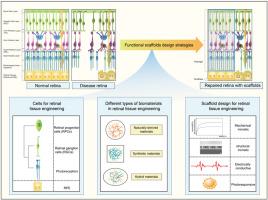视网膜修复与再生的功能支架设计策略
IF 10.2
1区 医学
Q1 ENGINEERING, BIOMEDICAL
引用次数: 0
摘要
人口老龄化给社会和医疗保健系统带来的压力不容低估。年龄相关性黄斑变性(AMD)是全球失明的主要原因,预计到2040年全球将有2.88亿人受到影响。目前AMD的治疗方案主要集中在疾病管理上,而不是提供一个明确的治愈方法。视网膜组织工程,旨在开发有针对性的再生策略来恢复或替换受损的视网膜组织,提供了开创性的进展,可以为AMD提供治疗解决方案,并彻底改变其治疗前景。这篇综述旨在提供视网膜修复和再生的生物材料策略的全面概述,特别关注支架的设计。为了有效地解决视网膜退行性疾病的潜在原因和开发功能支架,本文综述了视网膜解剖学、与退行性疾病相关的视力损害疾病和相关细胞类型。在此基础上,进一步讨论了各种支架设计策略,包括生物材料的选择,天然组织的结构和机械模仿,以及共培养支架的制造。除了目前的策略,我们还探索了潜在的特征,如导电和光响应,这可能会影响视网膜组织工程中支架设计的未来。总的来说,这些见解为推动和加速下一代视网膜组织工程支架的开发提供了一个强大的框架。本文章由计算机程序翻译,如有差异,请以英文原文为准。

Functional scaffolds design strategies for retinal repair and regeneration
The growing strain placed on both society and the healthcare system due to an ageing population should not be underestimated. Age-related macular degeneration (AMD) is a leading cause of blindness worldwide and is projected to affect 288 million people globally by 2040. Current treatment options for AMD primarily focus on disease management rather than offering a definitive cure. Retinal tissue engineering, which aims to develop targeted regenerative strategies to restore or replace damaged retinal tissues, offers pioneering advances that could provide curative solutions for AMD and revolutionize its therapeutic landscape. This review aims to provide a comprehensive overview of biomaterial strategies for retinal repair and regeneration, with a particular focus on scaffold design. To effectively address the underlying causes of retinal degenerative diseases and develop functional scaffolds, the review examines the retinal anatomy, the vision-impairing diseases associated with degeneration and relevant cell types. Building on this foundation, it further discusses various scaffold design strategies, including the selection of biomaterials, the structural and mechanical mimicry of native tissues, and the fabrication of scaffolds for co-culturing. Beyond current strategies, we also explore potential features, such as electrically conductive and photo-responsiveness, that could shape the future of scaffold design in retina tissue engineering. Collectively, these insights provide a robust framework to drive and accelerate the next generation of scaffold development for retinal tissue engineering.
求助全文
通过发布文献求助,成功后即可免费获取论文全文。
去求助
来源期刊

Materials Today Bio
Multiple-
CiteScore
8.30
自引率
4.90%
发文量
303
审稿时长
30 days
期刊介绍:
Materials Today Bio is a multidisciplinary journal that specializes in the intersection between biology and materials science, chemistry, physics, engineering, and medicine. It covers various aspects such as the design and assembly of new structures, their interaction with biological systems, functionalization, bioimaging, therapies, and diagnostics in healthcare. The journal aims to showcase the most significant advancements and discoveries in this field. As part of the Materials Today family, Materials Today Bio provides rigorous peer review, quick decision-making, and high visibility for authors. It is indexed in Scopus, PubMed Central, Emerging Sources, Citation Index (ESCI), and Directory of Open Access Journals (DOAJ).
 求助内容:
求助内容: 应助结果提醒方式:
应助结果提醒方式:


